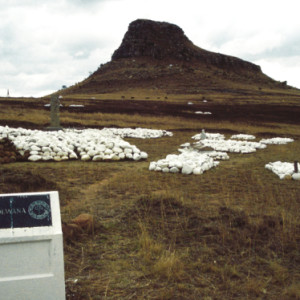An old door and a British defeat.
The nearest thing to inspiration that I found today was the ruinous door to the the green-keeper's shed on the golf links.
Extra. Meanwhile, the saga of the scanning of the contents of the little yellow boxes has taken me back to South Africa in the early '90s. This is a general view of the Isandlwana battlefield where the British Army suffered a crushing defeat at the hand of the Zulu nation. The low white cairns mark the mass graves of the British dead
According to Prof. Google, he Battle of Isandlwana on 22 January 1879 was the first major encounter in the Anglo–Zulu War between the British Empire and the Zulu Kingdom. Eleven days after the British commenced their invasion of Zululand in South Africa, a Zulu force of some 20,000 warriors attacked a portion of the British main column consisting of about 1,800 British, colonial and native troops and perhaps 400 civilians. The Zulus were equipped mainly with the traditional assegai iron spears and cow-hide shields, but also had a number of muskets and old rifles though they were not formally trained in their use. The British and colonial troops were armed with the modern] Martini-Henry breech-loading rifle and two 7-pounder mountain guns deployed as field guns, as well as a Hale rocket battery. Despite a vast disadvantage in weapons technology, the numerically superior Zulus ultimately overwhelmed the poorly led and badly deployed British, killing over 1,300 troops, including all those out on the forward firing line. The Zulu army suffered anywhere from 1000 to 2,500 dead. The battle was a decisive victory for the Zulus and caused the defeat of the first British invasion of Zululand. The British Army had suffered its worst defeat against an indigenous foe with vastly inferior military technology.


Comments
Sign in or get an account to comment.


